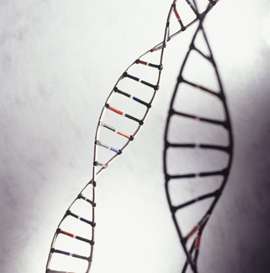Researchers break new territory analyzing DNA modifications in glioblastoma

Using state-of-the-art molecular biology and statistical approaches, researchers at Dartmouth's Norris Cotton Cancer Center (NCCC) have identified the functional role of two distinct DNA modifications in glioblastoma (GBM) tissues. The signature of one of these pattern disruptions in particular, 5hmC, had a particularly strong association with patient survival.
Glioblastoma (GBM) is a rare but deadly type of cancer that originates in the brain. Roughly 12,000 new cases are confirmed in the U.S. each year and its highly infiltrative nature renders it particularly difficult to treat.
One of the distorted molecular features of GBM is faulty epigenetic regulation. The epigenome involves modifications to DNA that dictate which genes are turned off and on within a particular cell-type. Defects here are known to contribute to cancer and current methods to predict brain tumor patient prognosis are based on epigenetic tumor subtypes. However, the epigenome is complex and there are recently discovered epigenetic marks that remain understudied in GBM.
Led by Cancer Center Member, Brock Christensen, PhD, Associate Professor of Epidemiology at Dartmouth's Geisel School of Medicine, researchers broke new territory by analyzing the profile of multiple DNA modifications, 5-methylcytosine (5mC) and 5-hydroxymethylcytosine (5-hmC), in a set of 30 glioblastomas in collaboration with clinicians at NCCC. "An intense interest has emerged in detailing the functional role of distinct DNA modifications in both healthy and disease tissues," said Christensen. "Here, we uncovered that specific DNA 5mC and 5hmC patterns are disrupted in GBM and uniquely characterize the molecular switches of the genome known as 'enhancers.' Importantly, we discovered that 5hmC signatures had a particularly strong association with patient survival." Their paper detailing these patterns, "5-Hydroxymethylcytosine localizes to enhancer elements and is associated with survival in glioblastoma patients," has been published in Nature Communications.
Previous technical limitations prohibited scientists from simultaneously studying high-resolution 5mC and 5hmC levels in a cancer genome. The Dartmouth study utilizes state-of-the-art molecular biology and statistical approaches, including the Dartmouth Discovery Computing Cluster and Nano String nCounter technology, to identify the levels of the distinct DNA modifications across the critical regions of the genome. "Together, our work reveals more about the powerful influence of the epigenome in cancer and highlights the distinct functional role of 5hmC," explains Christensen.
This was the first investigation to describe 5hmC distribution in the glioblastoma genome and its relationship with patient survival. Looking ahead, these findings suggest that future mapping of the epigenome in a larger cohort of brain tumors may improve prognosis and help inform treatments.
More information: Nature Communications, DOI: 10.1038/ncomms13177

















